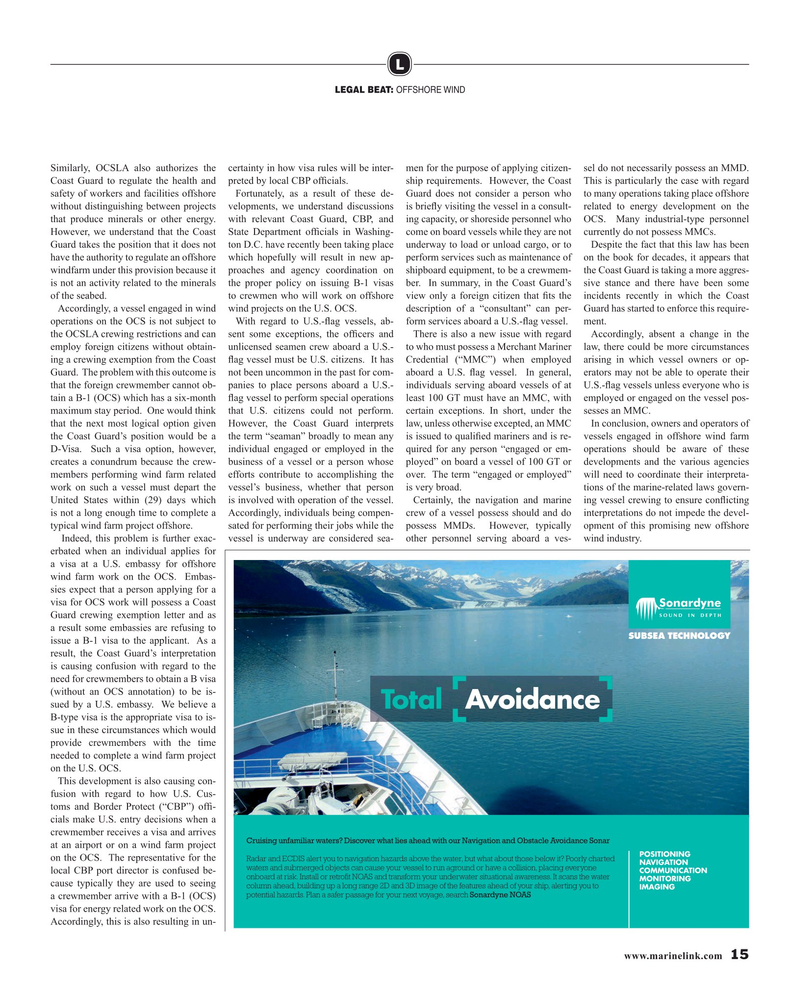
Page 15: of Maritime Reporter Magazine (July 2019)
Cruise Vessel Design & Outfit
Read this page in Pdf, Flash or Html5 edition of July 2019 Maritime Reporter Magazine
L
LEGAL BEAT: OFFSHORE WIND
Similarly, OCSLA also authorizes the certainty in how visa rules will be inter- men for the purpose of applying citizen- sel do not necessarily possess an MMD.
Coast Guard to regulate the health and preted by local CBP of? cials. ship requirements. However, the Coast This is particularly the case with regard safety of workers and facilities offshore Fortunately, as a result of these de- Guard does not consider a person who to many operations taking place offshore without distinguishing between projects velopments, we understand discussions is brie? y visiting the vessel in a consult- related to energy development on the that produce minerals or other energy. with relevant Coast Guard, CBP, and ing capacity, or shoreside personnel who OCS. Many industrial-type personnel
However, we understand that the Coast State Department of? cials in Washing- come on board vessels while they are not currently do not possess MMCs.
Guard takes the position that it does not ton D.C. have recently been taking place underway to load or unload cargo, or to Despite the fact that this law has been have the authority to regulate an offshore which hopefully will result in new ap- perform services such as maintenance of on the book for decades, it appears that windfarm under this provision because it proaches and agency coordination on shipboard equipment, to be a crewmem- the Coast Guard is taking a more aggres- is not an activity related to the minerals the proper policy on issuing B-1 visas ber. In summary, in the Coast Guard’s sive stance and there have been some of the seabed. to crewmen who will work on offshore view only a foreign citizen that ? ts the incidents recently in which the Coast
Accordingly, a vessel engaged in wind wind projects on the U.S. OCS. description of a “consultant” can per- Guard has started to enforce this require- operations on the OCS is not subject to With regard to U.S.-? ag vessels, ab- form services aboard a U.S.-? ag vessel. ment. the OCSLA crewing restrictions and can sent some exceptions, the of? cers and There is also a new issue with regard Accordingly, absent a change in the employ foreign citizens without obtain- unlicensed seamen crew aboard a U.S.- to who must possess a Merchant Mariner law, there could be more circumstances ing a crewing exemption from the Coast ? ag vessel must be U.S. citizens. It has Credential (“MMC”) when employed arising in which vessel owners or op-
Guard. The problem with this outcome is not been uncommon in the past for com- aboard a U.S. ? ag vessel. In general, erators may not be able to operate their that the foreign crewmember cannot ob- panies to place persons aboard a U.S.- individuals serving aboard vessels of at U.S.-? ag vessels unless everyone who is tain a B-1 (OCS) which has a six-month ? ag vessel to perform special operations least 100 GT must have an MMC, with employed or engaged on the vessel pos- maximum stay period. One would think that U.S. citizens could not perform. certain exceptions. In short, under the sesses an MMC. that the next most logical option given However, the Coast Guard interprets law, unless otherwise excepted, an MMC In conclusion, owners and operators of the Coast Guard’s position would be a the term “seaman” broadly to mean any is issued to quali? ed mariners and is re- vessels engaged in offshore wind farm
D-Visa. Such a visa option, however, individual engaged or employed in the quired for any person “engaged or em- operations should be aware of these creates a conundrum because the crew- business of a vessel or a person whose ployed” on board a vessel of 100 GT or developments and the various agencies members performing wind farm related efforts contribute to accomplishing the over. The term “engaged or employed” will need to coordinate their interpreta- work on such a vessel must depart the vessel’s business, whether that person is very broad. tions of the marine-related laws govern-
United States within (29) days which is involved with operation of the vessel. Certainly, the navigation and marine ing vessel crewing to ensure con? icting is not a long enough time to complete a Accordingly, individuals being compen- crew of a vessel possess should and do interpretations do not impede the devel- typical wind farm project offshore. sated for performing their jobs while the possess MMDs. However, typically opment of this promising new offshore Indeed, this problem is further exac- vessel is underway are considered sea- other personnel serving aboard a ves- wind industry. erbated when an individual applies for a visa at a U.S. embassy for offshore wind farm work on the OCS. Embas- sies expect that a person applying for a visa for OCS work will possess a Coast
Guard crewing exemption letter and as a result some embassies are refusing to issue a B-1 visa to the applicant. As a result, the Coast Guard’s interpretation is causing confusion with regard to the need for crewmembers to obtain a B visa (without an OCS annotation) to be is- sued by a U.S. embassy. We believe a
B-type visa is the appropriate visa to is- sue in these circumstances which would provide crewmembers with the time needed to complete a wind farm project on the U.S. OCS.
This development is also causing con- fusion with regard to how U.S. Cus- toms and Border Protect (“CBP”) of? - cials make U.S. entry decisions when a crewmember receives a visa and arrives at an airport or on a wind farm project on the OCS. The representative for the local CBP port director is confused be- cause typically they are used to seeing a crewmember arrive with a B-1 (OCS) visa for energy related work on the OCS.
Accordingly, this is also resulting in un- www.marinelink.com 15
MR #7 (10-17).indd 15 7/3/2019 9:11:06 AM

 14
14

 16
16
